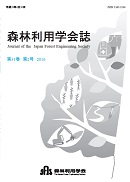Volume 36, Issue 1
Displaying 1-11 of 11 articles from this issue
- |<
- <
- 1
- >
- >|
SPECIAL ISSUE
-
The information-based forestry by the introduction of information and communication technology (ICT)Article type: other
2021Volume 36Issue 1 Article ID: 36.3
Published: January 31, 2021
Released on J-STAGE: March 21, 2021
Download PDF (682K)
ARTICLE
-
Article type: research-article
2021Volume 36Issue 1 Article ID: 36.5
Published: January 31, 2021
Released on J-STAGE: March 21, 2021
Download PDF (1006K)
RESEARCH AND TECHNICAL REPORT
-
Article type: rapid-communication
2021Volume 36Issue 1 Article ID: 36.13
Published: January 31, 2021
Released on J-STAGE: March 21, 2021
Download PDF (1033K) -
Article type: rapid-communication
2021Volume 36Issue 1 Article ID: 36.21
Published: January 31, 2021
Released on J-STAGE: March 21, 2021
Download PDF (929K)
RESEARCH AND TECHNICAL NOTE
-
Article type: other
2021Volume 36Issue 1 Article ID: 36.27
Published: January 31, 2021
Released on J-STAGE: March 21, 2021
Download PDF (930K) -
Article type: other
2021Volume 36Issue 1 Article ID: 36.31
Published: January 31, 2021
Released on J-STAGE: March 21, 2021
Download PDF (863K) -
Article type: other
2021Volume 36Issue 1 Article ID: 36.37
Published: January 31, 2021
Released on J-STAGE: March 21, 2021
Download PDF (873K)
ARTICLE
-
Article type: research-article
2021Volume 36Issue 1 Article ID: 36.43
Published: January 31, 2021
Released on J-STAGE: March 21, 2021
Download PDF (1003K)
RESEARCH AND TECHNICAL REPORT
-
Article type: rapid-communication
2021Volume 36Issue 1 Article ID: 36.51
Published: January 31, 2021
Released on J-STAGE: March 21, 2021
Download PDF (939K) -
Article type: rapid-communication
2021Volume 36Issue 1 Article ID: 36.57
Published: January 31, 2021
Released on J-STAGE: March 21, 2021
Download PDF (921K) -
Article type: rapid-communication
2021Volume 36Issue 1 Article ID: 36.63
Published: January 31, 2021
Released on J-STAGE: March 21, 2021
Download PDF (862K)
- |<
- <
- 1
- >
- >|
